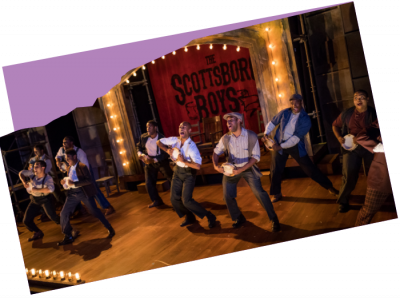Your donation sets the stage for a new season of Boston's most intimate, entertaining and provocative plays and musicals. Our shows make powerful connections with our audiences-- and they are only possible because of you.
Cultivating the Girl Within
Cultivating the Girl Within
Harvey Fierstein’s Casa Valentina is modeled on the Chevalier d’Eon Resort, a real-life, mid-20th century house and bungalow retreat for cross-dressers in the Catskills, named for a notorious 18th century French diplomat, spy, and transvestite. Susanna/Tito and Marie Valenti (Fierstein’s inspiration for Valentina/George and Rita in Casa Valentina) purchased the property in the mid-1950s, then relocated the business in 1964 to a rambling Victorian surrounded by 150 acres in Hunter, New York. They called it Casa Susanna.
Both locations were off-season hideaways where avowedly straight men—husbands, fathers, and sons who liked dressing up as women—got together to unwind in wigs, hose, and heels. Guests paid $25 (just shy of $200 in 2015) for room, board, and lessons on passing for female. Marie Valenti, who owned a New York City wig boutique that catered to professional female impersonators, cooked for guests and assisted her husband, who gave advice on such essentials as applying lipstick, highlighting the eyes with jet-black liner, and teasing wigs into bouffant hairdos.
By most accounts, Tito Valenti was a court translator who emigrated to the U.S. from Cuba some time in the mid-1940s. As Susanna, Valenti wrote a popular opinion column called “Susanna Says” for Transvestia, a bimonthly magazine published by Virginia Prince, a pioneer transgender activist, founder of Tri-Ess (Society for the Second Self), and the basis for the character of Charlotte Price.
Initially, according to independent historians and academics who’ve written about Transvestia, “Susanna Says” was a mix of gossip, fashion tips, and advice on self-awareness and self-improvement. The column evolved into a platform on which Valenti developed and extolled her belief that transvestites who practiced the art of cross-dressing harbored a second self—a dormant feminine personality she called “the girl within.” That “inner femininity” is what distinguished true transvestites from drag queens and fetishists, according to Susanna. Transvestia, according to its own description, was “dedicated to the needs of the sexually normal individual” who has discovered his “’other side’ and seeks to express it.” “Sexually normal,” in this context, meant heterosexual; Prince and Valenti were adamant about maintaining distinctions between transvestites and homosexuals, transsexuals, and others they considered deviant.
Transvestism isn’t portrayed much on page, stage, or screen, and the Valentis’ lives and livelihood might never have come to light —or caught the attention of Harvey Fierstein— were it not for Robert Swope, a musician and mid-century furniture dealer. Rummaging through old snapshots in New York City’s West 26th Street flea market some time in 2004, he came across an image of “what was obviously a drag queen on an ugly sofa with plastic slipcovers happily knitting while dressed in conservative women’s daywear.” It turned out to be one among a trove of more than 300 photos—some loose snapshots, others arranged in albums that had once belonged to Susanna Valenti, a “professional female interpreter,” according to a business card affixed to one of the albums. Swope bought the lot, and he and his partner Michel Hurst turned the best into Casa Susanna, which was published in 2005 by PowerHouse Books.
The book is an extraordinary publication. Sometimes striking (a few photos show men vamping in provocative outfits), it is more often as mundane and touching as a family photo album, put together to preserve memories of ordinary people marking happy moments. Page after page feature men posed in well-put-together outfits, frequently wearing the requisite hats, gloves, and tasteful jewelry ladies of the era donned for an evening out. There are also candid shots of people cooking, playing cards and Scrabble, smoking, and drinking a little early in the day. These weekenders are dressed casually, but with care. Most of them appear to be wearing nylon stockings—garments that, it should be noted, were held in place by girdles and garter belts in those pre-pantyhose days.
With the book’s release, one-time guests at Chevalier d’Eon and Casa Susanna emerged to share their recollections. Researchers and writers also developed an interest.
The story that emerges from their accounts is the source of the dramatic tension in Casa Valentina. Set in June of 1962, seven years before Stonewall and at a time when second-wave feminism was gathering strength, the play anticipates questions and conflicts over sexuality, gender, and social expectations that would emerge within the gay pride and women’s liberation movements. It also foreshadows a convention of transvestites Susanna hosted at Chevalier d’Eon on Halloween of 1962 to consider strategies that would make cross-dressing legal and socially acceptable.
Some 70 male cross-dressers, several of their spouses and a handful of psychologists from the Kinsey Report are said to have attended the retreat, where Susanna and Virginia were distressed to find more diversity of beliefs, tastes, and opinion in their loosely knit community than they would have preferred. Not all conventioneers shared their concerns about respectability and social decorum. That was particularly true of at least one guest, who didn’t bother dressing up and at one point lit a cigar.
In October 1969, Susanna told Transvestia readers she had decided to live full-time as female. She had lost the “fabulous thrill” that came from transforming Tito to Susanna, and loathed switching back. She said nothing about her relationship with Marie, or what Marie thought about her decision.
Prince wrote, published, and, continually generated controversy over her positions on the traditional family (which she supported) and homosexuality (which she scorned). Prince died in 2009. No one seems to know what happened to Susanna/Tito or Marie.
– Maureen Dezell
 Past Productions
Past Productions Primary Trust
Primary Trust Lizard Boy: A NEW MUSICAL
Lizard Boy: A NEW MUSICAL JOB
JOB The Antiquities
The Antiquities Swept Away
Swept Away




